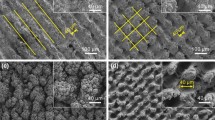Abstract
To determine mirror surface finishing conditions and efficient and economical superfinishing conditions for pure titanium and titanium alloys, an abrasive film is used when superfinishing is performed under varying conditions. These conditions include the workpiece rotation speed, the oscillation speed, the contact pressure of the roller, the hardness of the roller, and the type of abrasive film. The superfinishing device is applied to polishing a thin and long cylindrical bar. A micro-finishing film and a lapping film were used as abrasive films. Al2O3 grains or SiC grains were used as abrasives. The surface roughness of a polished workpiece was measured using a stylus-type surface-roughness measuring instrument. As a result, the conditions to improve the polishing surface efficiently include high values for the workpiece rotation speed, oscillation speed and contact pressure. The roller hardness has no effect on the efficient polishing conditions. The mirror finish of a surface can be created using lapping film of 3 μm with Al2O3 grains after polishing to a steady surface roughness under the efficient polishing conditions.
Similar content being viewed by others
References
SHIN O C, JUNG S R, JUNG Y G. Development of internal superfinishing system use abrasive film [J]. The Korean Society of Machine Tool Engineers, 2007: 154–159. (in Korean)
JUNG S Y, SHIN O C, JUNG Y G. A study on the practical application conditions of polishing film for high-efficiency superfinishing [J]. The Korean Society of Manufacturing Process Engineers, 2008(11): 115–121. (in Korean)
KIM J S, SHIN O C, JUNG Y G. A study on mirror surface finishing conditions of titanium using polishing film [J]. The Korean Society of Manufacturing Process Engineers, 2010(5): 245–246. (in Korean)
KIM J S, PARK K B, SHIN O C, JUNG Y G. A study on superfinishing characteristics of titanium using polishing film [J]. The Korean Society for Precision Engineering, 2009(10): 259–260. (in Korean)
LEE S M, CHAE S S, LEE C S, KIM T S, PARK H K, JUNG J S, JUNG H T, JUNG C Y, LEE J C. A study on the development of miniaturization & module for super finishing unit using lapping film [J]. The Korean Society of Manufacturing Process Engineers, 2009(11): 96–97. (in Korean)
SHIN O C, JUNG S R, JUNG S Y. A basic study on the polishing conditions of internal superfinishing using abrasive film [J]. The Korean Society of Machine Tool Engineers, 2008: 155–160. (in Korean)
SHIN O C. A basic study on the internal superfinishing effect using abrasive film [J]. The Korean Society of Manufacturing Process Engineers, 2009(11): 61–62. (in Korean)
CHANG S H, FARRIS T N, CHANDRASEKAR S. Contact mechanics of superfinishing [J]. American Society Mechanical Engineers, 2000, 122(2): 388–393.
CHANG S H, FARRIS T N, CHANDRASEKAR S. Experimental characterization of superfinishing [J]. Proceedings of the Institution of Mechanical Engineers: Part B, 2003, 217(7): 941–952.
PUTHANANGADY T K, MALKIN S. Experimental investigation of the superfinishing process [J]. Wear, 1995, 185(1/2): 173–182.
RECH J, KERMOUCHE G, CLAUDIN C, KHELLOUKI A, GRZESIK W. Modelling of the residual stresses induced by belt finishing on a AISI52100 hardened steel [J]. International Journal of Material Forming, 2008, 1(1): 567–570.
RECH J, KERMOUCHE G, GRZESIK W, GARCIA-ROSALES C, KHELLOUKI A, GARCIA-NAVAS V. Characterization and modelling of the residual stresses induced by belt finishing on a AISI52100 hardened steel [J]. Journal of Materials Processing Technology, 2008(1/3): 187–195.
KHELLOUKI A, RECH J, ZAHOUANI H. The effect of abrasive grain’s wear and contact conditions on surface texture in belt finishing [J]. Wear, 2007, 263(1–6): 81–87.
KIM H B, KIM K S, NAMGUNG S. A study on the mirror surface finishing of SM45C using micro abrasive film [J]. The Korean Institute of Industrial Educators, 1997, 22(1): 190–198.
JUNG S Y, PARK K B, JUNG Y G, JUNG S Y. An experimental study on the determination of efficient superfinishing conditions using polishing film [J]. The Korean Society for Precision Engineering, 2009, 26(8): 55–61. (in Korean)
KIM J S, JUNG Y G, SHIN O C. The determination of efficient superfinishing conditions for the mirror surface finishing of titanium [J]. The Korean Society of Manufacturing Process Engineers, 2010(11): 25–26. (in Korean)
Author information
Authors and Affiliations
Corresponding author
Additional information
Foundation item: Work supported by the Second Stage of Brain Korea 21 Projects of Korea
Rights and permissions
About this article
Cite this article
Kim, Js., Lim, Es. & Jung, Yg. Determination of efficient superfinishing conditions for mirror surface finishing of titanium. J. Cent. South Univ. Technol. 19, 155–162 (2012). https://doi.org/10.1007/s11771-012-0985-6
Received:
Accepted:
Published:
Issue Date:
DOI: https://doi.org/10.1007/s11771-012-0985-6




